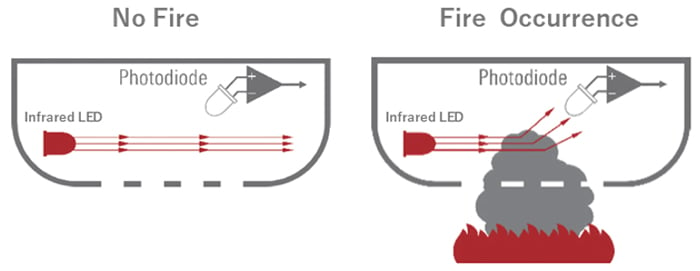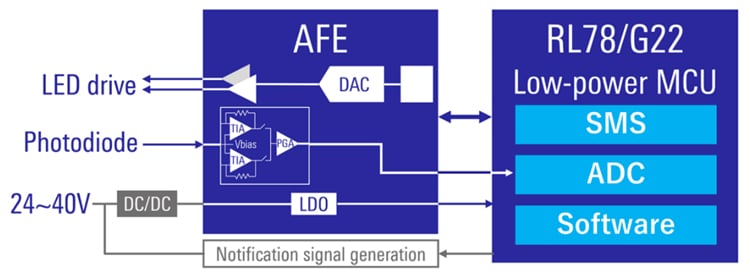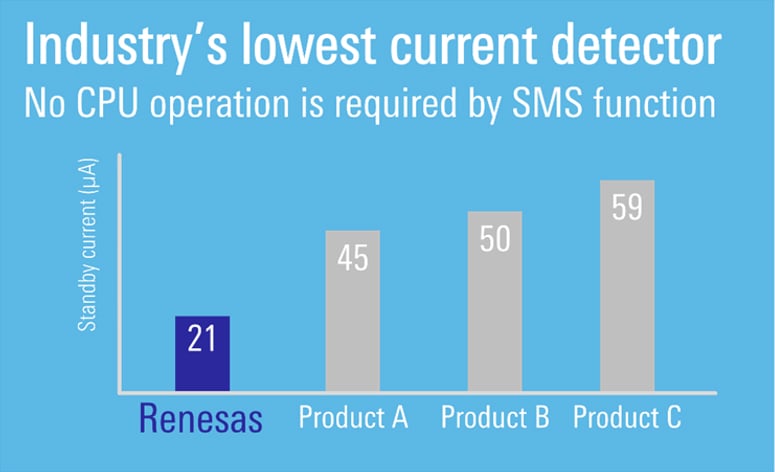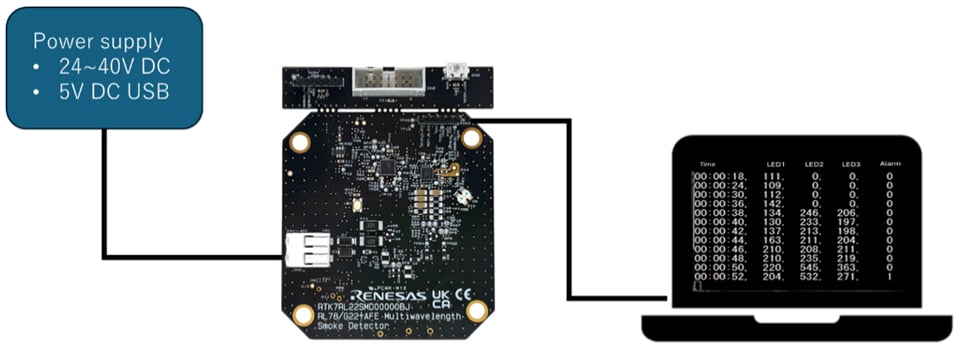In recent years, with the rapid development of smart buildings and large-scale commercial facilities, safety has become one of the most critical concerns. In commercial buildings, a fire can quickly lead to severe casualties and significant property loss. As a result, most countries mandate the installation of fire alarm systems in commercial properties, driving steady global growth in the smoke detector market. However, the widespread use of polymer materials such as polyurethane (PU) in modern construction has introduced new challenges. Fires involving these materials produce denser smoke with finer particles, making it harder for traditional smoke detectors to identify smoke accurately. This trend has raised the bar for detection performance and reliability.
Renesas' smoke detector solution is developed in compliance with the UL 268 standard. It not only meets the market demand for high accuracy and low false alarms but also features ultra-low power consumption, helping operators reduce deployment and operational costs. In the following sections, we will explore the key advantages of this solution.
How Smoke Detectors Work
In the market, the most common types of smoke detectors include ionization, photoelectric, and heat-sensitive models. Among these, photoelectric smoke detectors are widely used due to their low cost and high sensitivity. The working principle is illustrated in the diagram below: a photoelectric smoke detector consists of an LED and a photodiode. Under normal conditions, the LED does not directly illuminate the photodiode, so no light signal is detected. However, when a fire occurs, smoke particles scatter the light emitted by the LED, allowing the photodiode to receive the signal. This change indicates the presence of smoke, triggering the alarm.

Traditional photoelectric smoke detectors typically rely on a single infrared LED to detect smoke. However, as industry standards become increasingly stringent, this approach is no longer sufficient to meet compliance requirements. The reason lies in the physics of light scattering: when the particle size of smoke is close to the wavelength of the incident light, scattering becomes most pronounced. To enhance sensitivity and meet these stricter standards, modern smoke detectors now incorporate multiple LEDs with different wavelengths. This design improves detection accuracy for smoke generated by various burning materials, enabling earlier fire detection while significantly reducing false alarms caused by cooking fumes or dust.

Renesas' Smoke Detector Solution
To meet the requirements of the UL 268 standard, Renesas offers a Multiwavelength Smoke Detector Solution designed for commercial buildings. The solution consists primarily of the RL78/G22 microcontroller, an analog front-end (AFE) IC, infrared LEDs, blue LEDs, and a photodiode. Considering the specifications required for smoke detectors in commercial buildings, the main power supply is designed for 24V to 40V, and the power input section includes a current-limiting circuit (< 160µA).

Key Advantages of the Solution
- High Detection Sensitivity: By leveraging the principle that light scattering efficiency varies with particle size and wavelength, the solution uses both blue LEDs and infrared LEDs to detect smoke more accurately.
- Reduced BoM Cost: Through a simplified architecture that integrates the microcontroller with the photoelectric smoke detector AFE IC, the design minimizes the use of external components and enables a more compact PCB layout.
- Ultra-Low Power Consumption: The RL78/G22 microcontroller used in this solution is among the industry's most power-efficient general-purpose microcontrollers (37.5µA/MHz during CPU operation and 200nA during STOP). Its built-in SNOOZE mode sequencer allows certain operations to run even while the CPU is in standby, significantly reducing overall system power consumption. Figure 4 compares the standby current consumption of this solution with existing products when powering LEDs and photodiodes intermittently under normal (non-fire) conditions.
Ultra-low power consumption is critically important for conventional fire alarm systems. In commercial buildings, conventional fire alarm systems are widely used due to their high cost-performance ratio. This solution is designed for conventional fire alarm systems consisting of detectors, controllers, and alarms. The lower the power consumption of each detector in a fire alarm system, the more smoke detectors can be connected within each subsystem area. By adopting Renesas’ smoke detector solution, sensor power consumption can be effectively reduced, which minimizes the number of subsystems required in a building and thereby lowers deployment costs.


Renesas' Smoke Detector Solution Evaluation Support
To facilitate customer evaluation, as shown in the figure below, the evaluation board can be connected to a PC, allowing Tera Term to read the parameters of each LED received by the photodiode and visualize the smoke detection process. This also makes it easier for customers to evaluate while adjusting parameters.
Note: This feature requires an additional USB-to-serial converter.

Innovative Smoke Detection Trends for Smart Buildings
With the development of smart buildings and IoT technologies, smoke detectors are evolving from "standalone alarm devices" into intelligent nodes within building safety networks. Future detectors will not only sense smoke but also leverage wireless communication and AI algorithms to enable remote monitoring, false alarm suppression, and predictive maintenance, becoming a core component of building security systems.
Low power consumption and high reliability are key to this transformation. By leveraging ultra-low power microcontrollers (RL78 and RA series), IoT technologies, and AI edge computing help customers achieve long-life, intelligent detection solutions. Renesas will continue driving the shift from "detecting safety" to "sensing the future," working with partners to build a smarter and safer building ecosystem.
